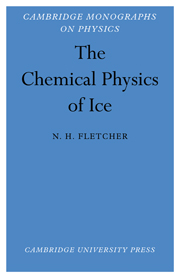4 results in Cambridge Monographs on Physics

Magnetic Oscillations in Metals
-
- Published online:
- 07 October 2011
- Print publication:
- 19 January 1984

Liquid State Physics
- A Statistical Mechanical Introduction
-
- Published online:
- 06 August 2010
- Print publication:
- 09 May 1974

Single Crystal Diffractometry
-
- Published online:
- 21 May 2010
- Print publication:
- 01 January 1966

The Chemical Physics of Ice
-
- Published online:
- 21 May 2010
- Print publication:
- 01 February 1970

